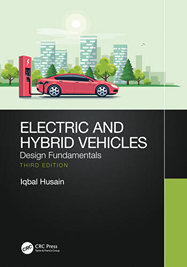Electric and Hybrid Vehicles Design Fundamentals
Material type: TextLanguage: English Publication details: Boca Raton, Fl : CRC Press, c2021Edition: 3rdDescription: XIX, 477 p. : illISBN:
TextLanguage: English Publication details: Boca Raton, Fl : CRC Press, c2021Edition: 3rdDescription: XIX, 477 p. : illISBN: - 9780367693930
- 629.2293 IQB
| Item type | Current library | Collection | Shelving location | Call number | Copy number | Status | Date due | Barcode |
|---|---|---|---|---|---|---|---|---|
 Lending Collection
Lending Collection
|
Circulation Section | Circulation Section | 629.2293 IQB | 2022-23 | Available | 98141 | ||
 Reference Collection
Reference Collection
|
TIEST (Thar) Library | Department of Electrical Engineering | Civil Engineering - Thar Institute | 629.2293 IQB | 2021-2022 | Available | 97638 |
Iqbal Husain is the ABB Distinguished Professor in the department of Electrical & Computer Engineering at North Carolina State University, Raleigh, NC. He is also the Director of the FREEDM NSF Engineering Research Center and the Director of Power Electronics for the PowerAmerica Institute at North Carolina State University.
SUMMARY:
A thoroughly revised third edition of this widely praised, bestselling textbook presents a comprehensive systems-level perspective of electric and hybrid vehicles with emphasis on technical aspects, mathematical relationships and basic design guidelines. The emerging technologies of electric vehicles require the dedication of current and future engineers, so the target audience for the book is the young professionals and students in engineering eager to learn about the area. The book is concise and clear, its mathematics are kept to a necessary minimum and it contains a well-balanced set of contents of the complex technology. Engineers of multiple disciplines can either get a broader overview or explore in depth a particular aspect of electric or hybrid vehicles.
Additions in the third edition include simulation-based design analysis of electric and hybrid vehicles and their powertrain components, particularly that of traction inverters, electric machines and motor drives. The technology trends to incorporate wide bandgap power electronics and reduced rare-earth permanent magnet electric machines in the powertrain components have been highlighted. Charging stations are a critical component for the electric vehicle infrastructure, and hence, a chapter on vehicle interactions with the power grid has been added. Autonomous driving is another emerging technology, and a chapter is included describing the autonomous driving system architecture and the hardware and software needs for such systems. The platform has been set in this book for system-level simulations to develop models using various softwares used in academia and industry, such as MATLAB®/Simulink, PLECS, PSIM, Motor-CAD and Altair Flux. Examples and simulation results are provided in this edition using these software tools.
The third edition is a timely revision and contribution to the field of electric vehicles that has reached recently notable markets in a more and more environmentally sensitive world.
